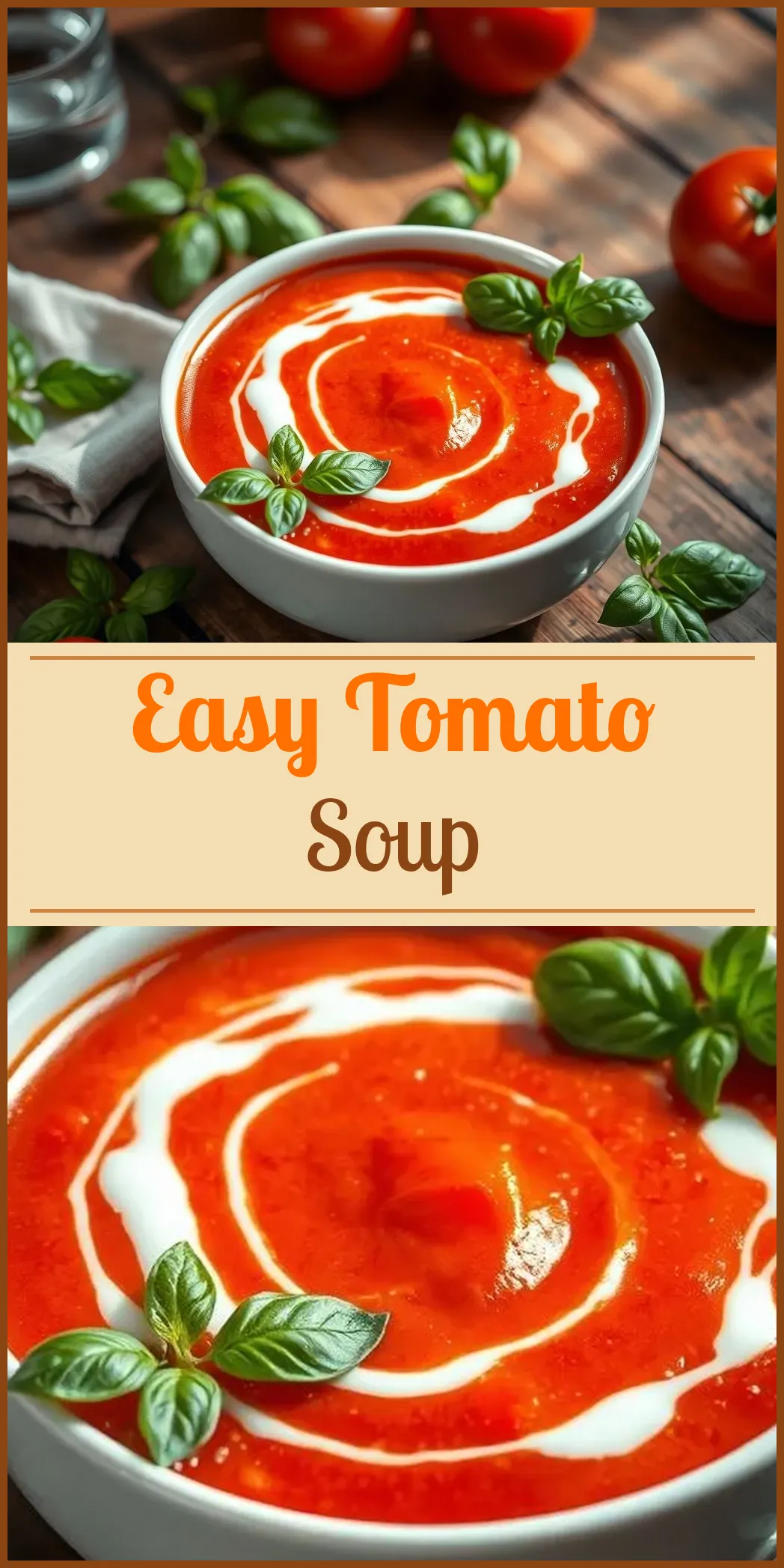Tomato soup is a timeless classic that warms you from the inside out. This hearty and aromatic dish makes for a perfect meal on cool days. Whether paired with a gooey grilled cheese sandwich or served on its own, this easy tomato soup recipe promises depth of flavor and comfort in every bowl.
Why You’ll Love This Recipe
I created this recipe for those busy evenings when you need a quick, delicious meal. I believe in using simple ingredients that are likely already in your pantry. This soup has a balanced mix of sweetness and tanginess, thanks to the tomatoes and a touch of sugar. A few herbs and spices round it out beautifully, bringing every flavor to life.
This recipe is excellent for:
– Weeknight dinners
– Lunches
– Meal preps and batch cooking

Pair it with a crunchy salad or a classic sandwich. The versatility of tomato soup makes it a great complement to many sides.
Ingredients and Their Roles
Each ingredient in this recipe plays a part in creating layers of flavor. Let’s break down what you’ll need and why it matters:
Core Ingredients
-
Olive Oil
Olive oil forms the base for sautéing your aromatics. It offers a subtle fruity flavor that deepens as it heats. -
Onions and Garlic
These aromatics give the soup its initial burst of flavor. Sautéing them releases natural sugars and fragrant oils. -
Canned Whole Peeled Tomatoes
Tomatoes are the star of this dish. Canned tomatoes work well because they are picked and preserved at peak ripeness. Keep the juice for extra flavor. -
Broth (Chicken or Vegetable)
Broth enhances the tomato flavor. Chicken broth adds richness, while vegetable broth keeps it light and vegan-friendly. -
Tomato Paste
Tomato paste adds depth and body. It intensifies the tomato essence and slightly thickens the soup.
Balancing and Enhancing Flavors
-
Sugar (Optional)
A small amount of sugar helps balance the acidity. Use it if you prefer smoother, sweeter notes. -
Basil
Dried or fresh basil introduces herbal depth. Fresh basil works nicely as a garnish. -
Salt and Pepper
These basic seasonings amplify all the other flavors. Season gradually to taste. -
Heavy Cream (Optional)
Adding cream at the end creates a luxurious, velvety finish. For a lighter version, skip this step.
Step-by-Step Cooking Process
Follow these steps to assemble and cook your tomato soup to perfection. This process ensures that each ingredient contributes its best.
1. Prepare the Aromatics
Start by heating olive oil in a large, non-reactive pot over medium heat. Stainless steel or ceramic pots are ideal to avoid any metallic taste from acidic tomatoes.
- Add the onions.
- Sauté until they soften, which takes about 5 minutes.
- Introduce the garlic.
- Cook for an extra minute. This prevents the garlic from burning and turning bitter.
By softening these ingredients, you release their natural sweetness. This forms the flavor foundation of your soup.
2. Integrate the Tomatoes
Pour in the entire can of whole peeled tomatoes along with its juice. Use a spoon to gently break apart any large chunks. Let the tomatoes simmer with the aromatics for a couple of minutes. This helps blend the flavors early on.
3. Build the Broth and Seasonings
Now, add the broth to the pot. This liquid serves as the soup’s body and brings the warmth and savory balance into play.
- Mix in tomato paste.
- Sprinkle sugar, if using.
- Add basil, salt, and pepper.
Stir all the ingredients gently. Reduce the heat and let the soup simmer for 20 minutes. The extended simmer time allows the flavors to marry together.
4. Create a Smooth Texture
For a silky consistency, blend the soup using an immersion blender directly in the pot. Alternatively, you can transfer the soup in batches to a standard blender. Blend until smooth, but be cautious with hot liquids. This step gives the soup that comforting, creamy texture many love.
5. Optional Cream Addition
When your soup reaches the desired consistency, stir in heavy cream if you prefer a richer texture. Start with a small amount and adjust to taste. The cream softens the acidity and deepens the overall flavor profile.
6. Taste and Final Adjustments
Always taste your soup towards the end. Sometimes a hint more salt or an extra pinch of basil elevates the dish. Adjust as needed. This final step ensures every spoonful is perfectly balanced.
Tips for the Best Tomato Soup
To make your tomato soup even more delightful, keep the following tips in mind:
Using a Non-Reactive Pot
Always choose a non-reactive pot when cooking acidic dishes. Materials like stainless steel, enamel-coated cast iron, or ceramic prevent any metallic flavors from developing.
Experimenting with Texture
- Puree vs. Chunky:
If you appreciate a rustic texture, only blend part of the soup. Leave some tomato pieces intact. - Using a Stand Blender:
If you do not have an immersion blender, a stand blender works well. Just remember to blend in small amounts to avoid overheating the appliance.
Flavor Adjustments
Be bold with your tasting. Adding a little extra sugar can tame excessive acidity. Conversely, for those who like a tangy bite, you can reduce or omit the sugar. Different brands of tomatoes may vary in acid levels, so personal taste is key.
Spicing It Up
If you enjoy a hint of warmth, consider adding red pepper flakes during the simmering process. Start with a small amount and adjust based on your heat preference.
Balancing Richness
Heavy cream adds a luxurious touch. If you want to lower the calorie count or achieve a lighter version, you might substitute cream with half-and-half or even blend in a bit of Greek yogurt just before serving.
Pairing Suggestions
Tomato soup pairs wonderfully with many sides. Here are some ideas to enhance your meal:
Classic Pairings
- Grilled Cheese Sandwich:
The melty, buttery texture of a grilled cheese perfectly complements the smoothness of tomato soup. It offers a nice contrast in flavor and texture. - Crusty Bread:
Serve with buttered baguette slices. The soft interior and crispy crust add a delightful crunch.
Salads and Sides
- Mixed Green Salad:
A fresh salad with a tangy vinaigrette can balance the rich soup. - Roasted Vegetables:
Try serving with lightly seasoned roasted vegetables. They bring natural sweetness and extra texture to the meal.
Creative Twists
- Egg Toast:
Top toasted bread with a poached egg for an extra dose of protein. - Herb Garnish:
Fresh basil or parsley not only brighten the dish visually but also enhance the flavor.
Storing and Reheating Your Soup
Making extra tomato soup is always a good idea. It stores well, making it perfect for batch cooking or meal prep.
Cooling and Refrigerating
Allow your soup to cool to room temperature before transferring it to an airtight container. Stored in the fridge, it remains fresh for up to 5 days.
Freezing Tips
- Container:
Use airtight containers or sturdy freezer bags. - Avoid Cream:
If you plan to freeze the soup, skip adding heavy cream until each serving is reheated. Cream can change texture when frozen. - Usage:
The soup can be safely frozen for up to 3 months. To reheat, thaw it overnight in the refrigerator and warm gently on the stove.
Serving Suggestions and Final Presentation
Presentation matters as much as taste. Here are a few ideas to make your tomato soup look as good as it tastes:
Garnishing Your Soup
- Fresh Herbs:
Sprinkle chopped fresh basil or parsley over the soup just before serving. - Drizzle of Olive Oil:
A light drizzle enhances the flavor and appearance. - Croutons:
Homemade croutons add a crunchy texture. Try using whole grain bread cut into cubes, lightly tossed in olive oil and herbs, then baked until golden.
Elegant Plating
For a restaurant-quality finish, serve your soup in a warmed bowl. Place a small slice of crusty bread or a mini grilled cheese on the side for an inviting presentation. Consider pairing the dish with a light, crisp salad.
Common Pitfalls and How to Avoid Them
Even simple recipes can sometimes stir up issues. Here are some common pitfalls to keep you on track:
Overcooking Aromatics
If you cook onions and garlic too long, they become bitter. Sauté until soft and translucent, not browned.
Insufficient Seasoning
Underseasoning can lead to a flat flavor. Season gradually and taste frequently. Layer flavors by adding seasoning at different stages.
Poor Blending
If you blend too aggressively, the texture might become too smooth. Adjust the blender speed to match your desired consistency. A slightly chunky texture can sometimes add more character to your soup.
Not Adjusting Acidity
Tomatoes vary in acidity. Always taste and adjust with a bit of sugar or additional salt, ensuring a balanced flavor.
Bringing It All Together
This easy tomato soup recipe is a wonderful blend of accessibility and flavor. By focusing on quality ingredients and careful preparation, you create a dish that is both satisfying and versatile. Whether you serve it at a small family dinner or bring it along for a lunch break at work, this soup never fails to impress.
Remember, the art of cooking is about personal touches. Feel free to experiment with herbs, spices, and even different types of tomatoes. Over time, this recipe can evolve into your own signature dish.
Enjoy each warm spoonful of this delightful tomato soup. Its perfect balance of acidity and creaminess is a testament to simple cooking done right. With practice, you might even uncover secret twists that make your version a beloved favorite for years to come.
This recipe stands as a tribute to comfort food—easy to prepare, satisfying to eat, and always inviting for another serving.
Happy cooking and enjoy every flavorful bowl!

Easy Tomato Soup
This classic tomato soup will warm you up from the inside out! It’s so easy to make at home. Plus, it’s so much better than the canned stuff!
Ingredients
- 1 teaspoon dried basil
- Fresh basil for garnish (optional)
- 1 medium onion, finely chopped
- 2 cloves garlic, minced
- Salt and pepper to taste
- 1/2 cup heavy cream (optional)
- 2 cups vegetable or chicken broth
- 2 tablespoons olive oil
- 2 tablespoons tomato paste
- 1 (28-ounce) can whole peeled tomatoes in juice
- 1 teaspoon sugar (optional)
Instructions
- Heat the olive oil in a large pot over medium heat. Add the onion and cook until it becomes translucent, which takes about 5 minutes. Then, add the minced garlic. Cook it for another minute until it becomes fragrant.
- Pour in the canned tomatoes. Include their juice. Break the tomatoes up a bit with a spoon.
- Stir in the broth, tomato paste, sugar (if using), and basil. Season it with salt and pepper to taste. Bring the mixture to a boil. Then, reduce the heat and simmer it for about 20 minutes.
- Puree the soup with an immersion blender until smooth. Alternatively, transfer it to a blender in batches.
- Stir in the heavy cream if using. Taste the mixture. Adjust for seasoning as needed. Add more salt, pepper, or sugar if necessary.
- Serve. Enjoy!




